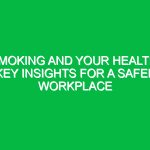Understanding Fatigue in the HSE Context
Fatigue increases the risk of accidents, injuries, and errors in a multitude of environments, particularly within the Health, Safety, and Environment (HSE) domain. It is a complex phenomenon that can stem from various sources—physical exertion, emotional stress, and insufficient rest. Understanding how fatigue contributes to risk is essential for ensuring Safety and compliance in workplaces ranging from construction sites to corporate offices.
The relevance of fatigue in HSE cannot be overstated; it affects not just individual performance but also team dynamics and overall organizational Safety. In this article, we will delve into the intricacies of how fatigue increases the risk of incidents, explore the science behind fatigue, and discuss effective strategies to mitigate its impact.
The Science Behind Fatigue
Fatigue manifests in different forms, including physical fatigue, mental fatigue, and emotional exhaustion. Each type influences performance in unique ways.
- Physical Fatigue: This type occurs when muscles are overworked, leading to reduced strength and endurance. In high-demand jobs such as construction or manufacturing, workers may find themselves unable to perform tasks effectively when physically fatigued.
- Mental Fatigue: This is the result of prolonged cognitive activity, leading to decreased concentration, slower reaction times, and impaired decision-making. In roles that require high levels of focus, like operating heavy machinery, mental fatigue can significantly increase the risk of accidents.
- Emotional Exhaustion: Often related to stress and burnout, emotional fatigue can lead to irritability and reduced morale. This can affect teamwork and communication, further increasing the risk of safety incidents.
Research shows that fatigue compromises cognitive functions, including attention, judgment, and reaction time, which are crucial in maintaining safety in the workplace. For instance, according to a study published in the “Journal of Safety Research,” fatigue can lead to a 50% increase in the likelihood of errors in high-stakes environments.
How Fatigue Increases Risk in the Workplace
The implications of fatigue are profound. The following points illustrate how fatigue increases the risk of incidents in various sectors:
1. Increased Likelihood of Accidents
Fatigue increases the risk of workplace accidents significantly. In industries where safety is paramount, such as construction or manufacturing, a fatigued worker is more likely to overlook safety protocols, misjudge distances, or fail to respond promptly to Hazards. For example, a construction worker who has not had adequate rest may miscalculate the weight of materials, leading to potential accidents.
2. Decreased Productivity
While it may seem counterintuitive, fatigue can actually lead to decreased productivity. Workers who are fatigued tend to take longer to complete tasks, leading to delays and reduced overall output. This not only affects individual performance but can ripple through an entire team or project.
3. Impaired Decision-Making
Fatigue affects cognitive abilities, leading to poor decision-making. In high-stakes situations, such as emergency response or healthcare, the consequences of impaired judgment can be dire. For instance, a fatigued nurse may overlook critical patient signs, leading to severe health implications.
4. Increased Stress and Burnout
Chronic fatigue can lead to increased stress levels and ultimately burnout. An exhausted workforce is less engaged, more prone to absenteeism, and may struggle with mental health issues. This creates a vicious cycle where increased fatigue leads to lower morale and further risks.
Identifying the Signs of Fatigue
To effectively combat fatigue in the workplace, it is crucial to recognize its signs. Here are some key indicators:
- Frequent yawning or difficulty keeping eyes open
- Increased irritability or mood swings
- Difficulty concentrating or remembering tasks
- Physical symptoms such as headaches or gastrointestinal issues
- Reduced motivation or enthusiasm for work
Recognizing these signs early can help in implementing preventive measures before fatigue escalates into a significant risk.
Best Practices to Mitigate Fatigue in the Workplace
Organizations must proactively address the issue of fatigue to enhance safety and productivity. Here are several Best Practices:
1. Implementing Work-Hour Policies
Establishing clear guidelines around work hours is essential. Limiting consecutive working hours and ensuring adequate breaks can help reduce fatigue levels. For instance, many industries adopt the “20-20-20 rule,” encouraging workers to look at something 20 feet away for 20 seconds every 20 minutes to relieve eye strain.
2. Encouraging a Healthy Work-Life Balance
Promoting a culture that values work-life balance can alleviate stress and fatigue. Employers should encourage employees to take their vacation days and ensure they are not overworked. This not only improves morale but also enhances overall productivity.
3. Providing Adequate Training
Training programs should include education on the importance of recognizing fatigue and its implications for safety. Workers should be equipped with strategies to manage their energy levels effectively. For example, training could include stress management techniques or time management skills.
4. Designing Work Environments for Comfort
Creating a work environment that minimizes fatigue is essential. This includes ergonomic workstations, adequate lighting, and a clean, organized workspace. For instance, a construction site that is well-lit and organized can significantly reduce the chances of accidents caused by fatigue.
5. Regular Health Check-Ups
Employers should offer regular health assessments to monitor worker well-being. Health screenings can help identify workers at risk of fatigue-related issues and provide them with the necessary support.
Regulations and Standards Addressing Fatigue
Various Regulations set forth by organizations such as the Occupational Safety and Health Administration (OSHA) address fatigue in the workplace. These regulations emphasize the need for employers to provide a safe working environment and to be aware of fatigue-related risks.
For example, osha has guidelines regarding shift work and the potential for increased fatigue risks, particularly in industries like transportation and healthcare. Adhering to these regulations not only protects workers but also enhances organizational responsibility.
Conclusion
Fatigue increases the risk of numerous workplace incidents, affecting not only individual safety but also organizational efficiency and morale. By understanding the implications of fatigue and implementing effective strategies to combat it, companies can create safer, more productive work environments.
As we continue to navigate the complexities of modern work life, it is crucial to prioritize fatigue management in our safety protocols. Organizations that recognize and address this issue not only comply with legal obligations but also foster a culture of care and responsibility towards employees.
In a world that often glorifies work over rest, it is time to rethink our approach to fatigue management. A well-rested workforce is not just a safer workforce; it is a more engaged, productive, and resilient one. Let’s advocate for practices and policies that value health, safety, and the well-being of all workers.


